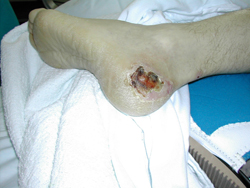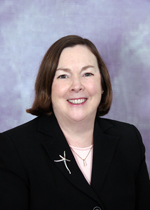 |
Pressure ulcers such as this are common among bedridden patients. UNMC’s Joyce Black, Ph.D., and Janet Cuddigan, Ph.D., have helped shape new national policy that will help nurses and other health professionals spot pressure ulcers earlier. |
There are perhaps no stronger markers of the quality of care a patient receives than pressure ulcers — areas of skin that break down when a person stays in one position for an excessively long time without shifting his or her weight.
“Pressure ulcers are the only wounds that are counted as a quality of care measure by the federal government,” said Joyce Black, Ph.D., president of the National Pressure Ulcer Advisory Panel (NPUAP) and an associate professor in the UNMC College of Nursing. “People have gone to court over them. Nurses have lost their licenses because of them.”
Dr. Black and Janet Cuddigan, Ph.D., associate professor in the College of Nursing, have helped NPUAP redefine the definition of a pressure ulcer and the stages of the wound’s development.
Pressure ulcer severity was originally broken down into four stages with the first stage indicating the first signs of a developing ulcer. The wound becomes more severe in each stage up to the fourth stage, which is a bone deep wound.
The NPUAP has added two more stages — suspected deep tissue injury and unstageable pressure ulcers.
Deep tissue injuries are often not suspected of being a pressure ulcer right away, Dr. Black said. They can occur when the patient has suffered another trauma such as a stroke and has been lying in one position for a long period of time before being moved.
 |
Joyce Black, Ph.D. |
 |
Janet Cuddigan, Ph.D. |
“A description of a deep tissue injury was never included in the staging system before,” Dr. Black said. “We hope this helps more nurses to recognize this type of injury and prevent the worsening pressure ulcer from occurring.”
Unstageable pressure ulcers are severe wounds in which the base of the ulcers are covered by tissues that make it hard to determine how deep the injury runs.
The additional definitions and further descriptions of the existing four stages were five years in the making, said Dr. Cuddigan, co-chairwoman of the International Pressure Ulcer Guideline Panel and Treasurer of the NPUAP.
“Our goal was to clarify how to properly identify, diagnose, treat and prevent these wounds,” Dr. Cuddigan said.
The nursing community has been very receptive of the changes, Dr. Black said.
“A lot of people have written me and said ‘thank you for clarifying this,’ ” she said.